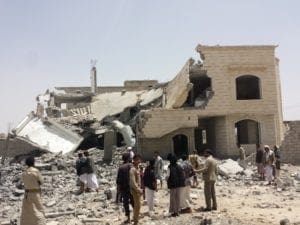America’s Ally is Decimating the Yemeni Population, What’s Behind the Silence?
This article was featured in our weekly newsletter, the Liberator Online. To receive it in your inbox, sign up here.
Saudi Arabia, a United States ally in the Middle East, has been leading a heavily interventionist policy in Yemen for the past year. The war between factions claiming to represent the Yemeni people has led to a “catastrophic” crisis in the region, but Saudi Arabia, along with America, have played important roles.
 So far, over two million people have been displaced from their homes while countless others lack access to basic services and necessities such as water and food. According to The American Conservative’s Daniel Larison, most of the damage caused by war over the last year in Yemen is due to Saudi Arabia and their allies.
So far, over two million people have been displaced from their homes while countless others lack access to basic services and necessities such as water and food. According to The American Conservative’s Daniel Larison, most of the damage caused by war over the last year in Yemen is due to Saudi Arabia and their allies.
Prior to the military intervention, most Yemenis depended on humanitarian aid. As the war deepened, their needs have only grown. As aid groups struggle to help in any way, they are also faced with challenges brought about the blockades placed and enforced by Saudi Arabia since 2015. While both the United States and the United Kingdom governments have allegedly attempted to persuade the Saudis by urging them to change their tactics, Saudi officials continue to have access to American weapons.
In 2015, the United States sold $33 billion in weapons to Gulf allies, including Saudi Arabia. According to the State Department, the deal between the US government and Saudi Arabia allows Saudi officials to purchase everything from attack helicopters to ballistic missile defense systems, despite the fact Saudi Arabia continues to uphold a blockade that is effectively decimating the Yemeni population.
At the moment, about 19 million people in Yemen lack access to water and sanitation while over 14 million Yemenis also require urgent health services. Out of the 14 million Yemenis requiring medical attention, at least 2 million are children, pregnant, and lactating women who are also malnourished.
As Saudi Arabia continues to uphold the blockade while targeting insurgents, Yemen slips into a much greater crisis. In the meantime, America remains complicit. Not only because it has been virtually silent over the past 12 months, but also because it continues to sell heavy weaponry to the Gulf state.
As the same administration that claimed to have a “responsibility” to protect Libyans turns a blind eye to the crisis in Yemen, the Saudis are effectively starving Yemenis to death.
In an article for the Cato Institute, A. Trevor Thrall and John Glaser argue that America should distance itself from Saudi Arabia, especially after the Yemen civil war began. “Yemen,” the authors begin the article, “is the latest U.S. foreign policy disaster.”
According to the Cato report, Saudi Arabia’s “ruthless” military campaign in Yemen has been enabled by the United States from the get-go.
The initial conflict started when Ali Abdullah Saleh, a long-time US-Saudi ally, was overthrown. Following the deposition, Abed-Rabbo Mansour Hadi became the president of the transitional government. Hadi was the only candidate on the ballot and he counted with the support of both the United States and Saudi Arabia. In 2014, however, Yemen’s Shiite Houthi rebels launched an insurgency, taking control of the capital city, Sanaa. Once Saudi Arabia started a bombing campaign in March of 2015 to contain the Houthis, Glaser and Thrall write, the civil war “morphed into an intractable proxy war.”
Since the Saudis see the Houthis as Iran proxies, the United States’ nuclear deal with Iran may seem as stab in the back to Saudi Arabia. According to the Cato scholars, “U.S. officials have apparently felt obliged to reassure Saudi Arabia by supporting its war in Yemen.” In light of these issues, we must ask ourselves: Why is America still supporting Saudi Arabia while also calling for the removal of Bashar al-Assad in Syria?




















